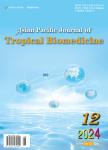Prevalence of refractive errors among primary school children in a tropical area,Southeastern Iran
Prevalence of refractive errors among primary school children in a tropical area,Southeastern Iran作者机构:Department of Optometry School of Paramedical Science Mashhad University of Medical Sciences Health Promotion Research Center Zahedan University of Medical Sciences
出 版 物:《Asian Pacific Journal of Tropical Biomedicine》 (亚太热带生物医学杂志(英文版))
年 卷 期:2016年第6卷第2期
页 面:181-184页
核心收录:
学科分类:1010[医学-医学技术(可授医学、理学学位)] 10[医学]
基 金:Supported by Zahedan University of Medical Sciences(Grant No.91-506)
主 题:Refractive error Myopia Hyperopia Astigmatism Anisometropia
摘 要:Objective: To determine the prevalence of refractive errors among primary school children in Zahedan District, Southeastern Iran, as a tropical ***: In this cross sectional study, a total of 400 students were selected randomly using multi-stage sampling technique. Myopia was defined as spherical equivalent(SE)of-0.5 diopter(D) or more, hyperopia was defined as SE of +2.00 D or more and a cylinder refraction greater than 0.75 D was considered astigmatism. Anisometropia was defined as a difference of 1 D or more between two eyes. Cycloplegic refractive status was measured using auto-refractometer(Topcon 8800). Data were analyzed using SPSS,version 22 software ***: Mean ± SD of SE was(1.71 ± 1.16) D. A total of 20 students [6.3%, 95%confidence interval(CI): 3.96%–9.64%] were myopic(-0.5 D), 186 students(58.1%,95% CI: 52.50%–63.56%) were hyperopic( +2.00 D) and 114 students(35.6%, 95%CI: 30.43%–41.18%) were emmetropic. The prevalence of astigmatism( 0.75 D)among students was 3.4%(95% CI: 1.82%–6.25%). Anisometropia of 1 D or more was found in 21.3%(95% CI: 16.98%–26.23%) of the studied population. The prevalence of refractive errors was higher among girls than boys(73.1% vs. 55.6%, P = 0.001), but it was not significantly different among different age groups(P = 0.790).Conclusions: Refractive errors affect a sizable portion of students in Zahedan. Although myopia is not very prevalent, the high rate of hyperopia in the studied population emphasizes its need for attention.



